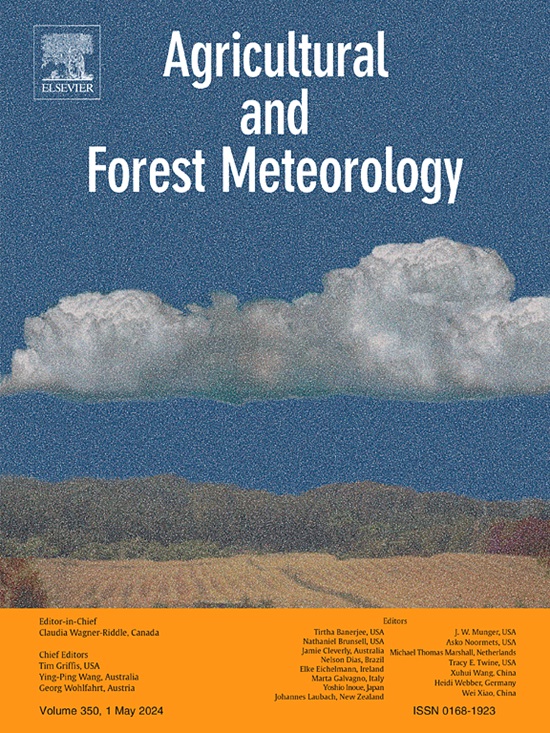Xylem hydraulic impairment due to stronger drought stress accounts for the reduced crown vitality and growth performance of Mongolian pine trees in higher-density plantations
IF 5.6
1区 农林科学
Q1 AGRONOMY
引用次数: 0
Abstract
Forest ecosystems worldwide are witnessing accelerated tree mortality caused by intensified drought under climate change. Tree density emerges as a pivotal factor affecting the stability of forests in water-limited areas; however, the physiological mechanisms by which stand density affects tree resilience to drought and forest stability remain elusive. Here, we conducted a comprehensive comparative analysis of Mongolian pine plantations with different densities (low, medium, and high) in a typical water-limited area of northern China. Employing a multi-faceted approach that integrates dendroclimatic analysis, individual tree-level physiological measurements, and forest canopy-level stress regime estimates based on drone-borne hyperspectral imagery, we sought to reveal the physiological mechanisms underlying the differences in growth vigor between Mongolian pine trees of different stand densities. We found that stand density had a strong influence on the performance of Mongolian pine plantations, with trees of higher-density stands exhibiting significantly lower radial growth rates and physiological traits reflecting stronger drought stress at both the individual and canopy levels. The dendroclimatic analysis underscored moisture as the primary environmental determinant for Mongolian pine growth in the study site. Comparisons between the selected relatively dry and wet years demonstrated that increased climate aridity exacerbated the density effect on hydraulic functioning. Across the stand densities and dry-wet climatic conditions, tree growth sensitivity to climatic variability linearly increased with leaf water status and xylem hydraulic efficiency but decreased with stem xylem embolism, portending that hydraulic impairment accounts for the diminished growth performance in denser stands. These findings highlight that stand density may modulate xylem hydraulic functionality by imposing on soil water availability and tree water status, thereby determining forest performance in water-limited areas. This research provides insights for sustainability-focused forestry management in drought-prone regions, advocating for tree density reduction that prioritizes xylem hydraulics to mitigate the negative impacts of drought on forest ecosystems.

在高密度人工林中,较强的干旱胁迫导致的木质部水力损伤是导致林冠活力和生长性能下降的主要原因
在气候变化的背景下,干旱加剧导致全球森林生态系统树木死亡加速。树木密度成为影响缺水地区森林稳定性的关键因素;然而,林分密度影响树木抗旱能力和森林稳定性的生理机制尚不明确。本文对中国北方典型缺水地区不同密度(低、中、高)的蒙松人工林进行了综合比较分析。采用多面方法,结合树木气候分析、单株树水平生理测量和基于无人机高光谱图像的森林冠层水平应力状态估计,我们试图揭示不同林分密度下蒙古松生长活力差异的生理机制。研究发现,林分密度对油松人工林的生长性能有较大影响,在个体和林冠水平上,林分密度越高,径向生长率越低,生理性状越强。树木气候分析强调湿度是研究地点蒙古松生长的主要环境决定因素。相对干旱和湿润年份的比较表明,气候干旱的增加加剧了密度对水力功能的影响。在不同的林分密度和干湿气候条件下,树木生长对气候变化的敏感性随着叶片水分状况和木质部水力效率的增加而线性增加,但随着茎木质部栓塞而降低,这表明在密度较大的林分中,水力损伤是导致生长性能下降的原因。这些发现突出表明,林分密度可能通过影响土壤水分有效性和树木水分状况来调节木质部的水力功能,从而决定缺水地区的森林绩效。该研究为干旱易发地区以可持续发展为重点的林业管理提供了见解,倡导降低树木密度,优先考虑木质部水力学,以减轻干旱对森林生态系统的负面影响。
本文章由计算机程序翻译,如有差异,请以英文原文为准。
求助全文
约1分钟内获得全文
求助全文
来源期刊
CiteScore
10.30
自引率
9.70%
发文量
415
审稿时长
69 days
期刊介绍:
Agricultural and Forest Meteorology is an international journal for the publication of original articles and reviews on the inter-relationship between meteorology, agriculture, forestry, and natural ecosystems. Emphasis is on basic and applied scientific research relevant to practical problems in the field of plant and soil sciences, ecology and biogeochemistry as affected by weather as well as climate variability and change. Theoretical models should be tested against experimental data. Articles must appeal to an international audience. Special issues devoted to single topics are also published.
Typical topics include canopy micrometeorology (e.g. canopy radiation transfer, turbulence near the ground, evapotranspiration, energy balance, fluxes of trace gases), micrometeorological instrumentation (e.g., sensors for trace gases, flux measurement instruments, radiation measurement techniques), aerobiology (e.g. the dispersion of pollen, spores, insects and pesticides), biometeorology (e.g. the effect of weather and climate on plant distribution, crop yield, water-use efficiency, and plant phenology), forest-fire/weather interactions, and feedbacks from vegetation to weather and the climate system.

 求助内容:
求助内容: 应助结果提醒方式:
应助结果提醒方式:


